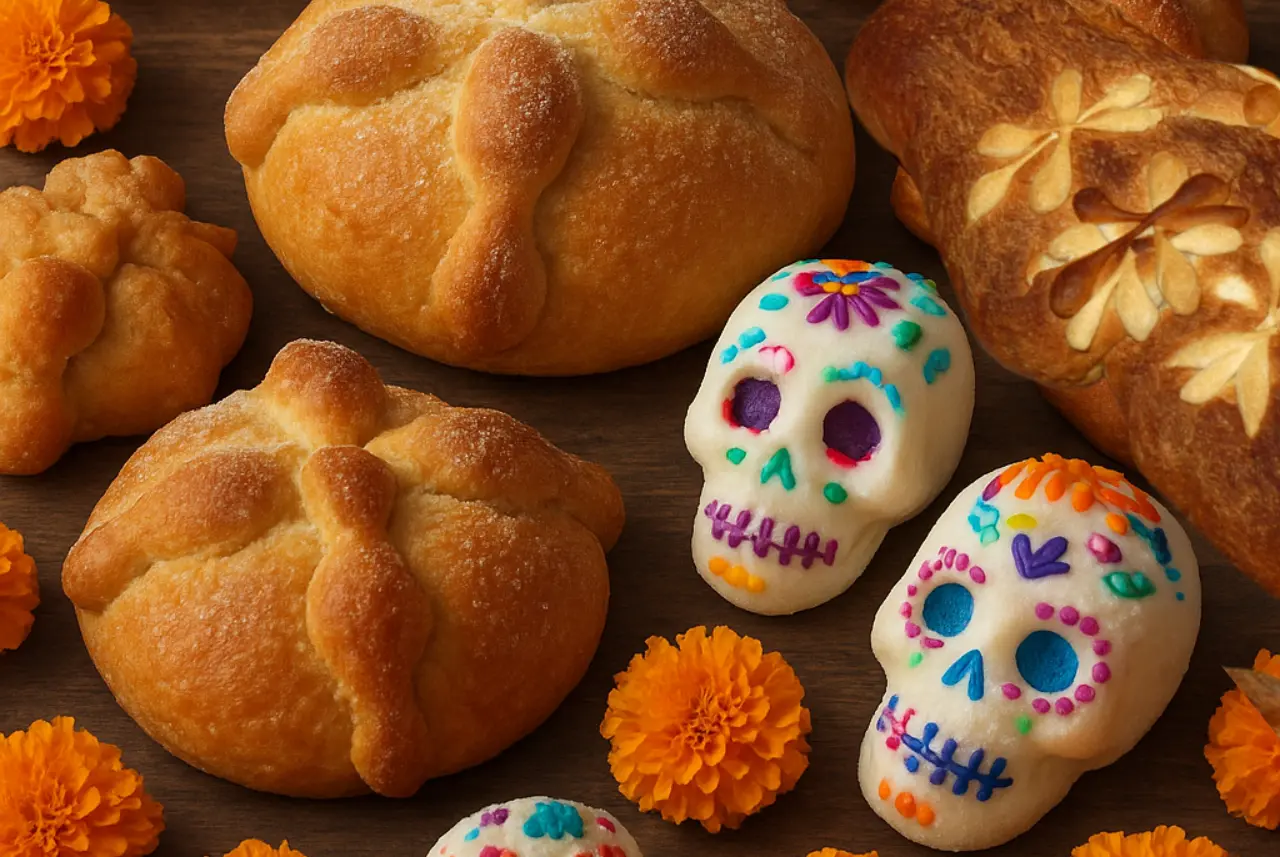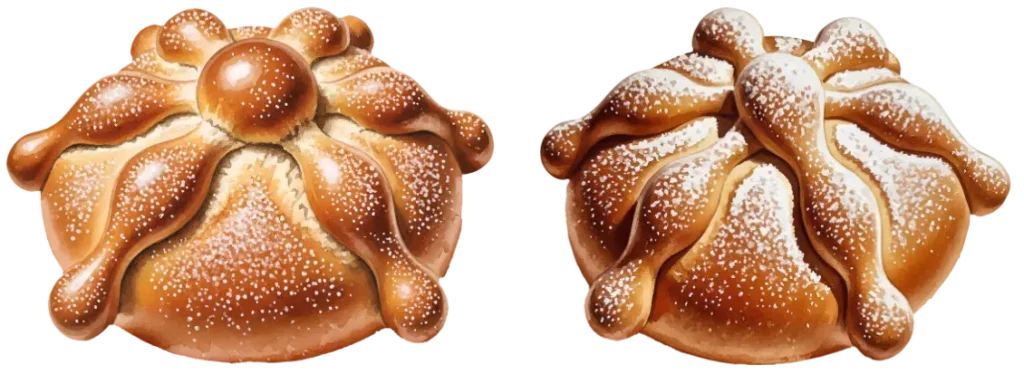
In the sweet aroma of the Mexican autumn, pan de muerto (bread of the dead) holds a sacred place on tables, altars, and in collective memory. More than food, it is an offering that honors life and the return of those who have departed, a tradition that sinks its roots in pre-Hispanic rituals and blooms each year with new forms, colors, and meanings throughout the country.
Pre-Hispanic Roots: The Bread Born from the Soul and from Corn
Before the arrival of the Spaniards, the original peoples of Mesoamerica offered their gods sacred foods made from corn and amaranth. The National Institute of Indigenous Peoples (INPI) documents that during ceremonies dedicated to the dead, breads such as papalotlaxcalli, or “butterfly bread,” were made exclusively for those rituals. It was a kind of tortilla upon which a butterfly-shaped seal—symbol of the soul—was pressed into the raw dough and later baked and painted with bright colors.
The Nahua cultures also prepared breads made of amaranth mixed with wasp or maguey honey, modeled in the shape of bones or lightning (xonicuille), along with special tamales called huitlatamalli. These foods were offered to the goddesses of death, such as Cihuapipiltin, protector of women who died in childbirth.
Friar Diego de Durán recounted that during the feast of Huitzilopochtli, the population ate nothing but tzoalli with honey. With that mixture, they made human figures and bones, which they placed at the feet of their idols—a practice that centuries later would inspire the symbolic form of today’s pan de muerto.
With the arrival of wheat and evangelization, ancestral offerings were transformed. Bread began to incorporate European elements such as yeast and sugar but preserved its spiritual meaning: to represent the continuity of life and the return of the soul during the Day of the Dead.
In its most recognized form, the round bread with crossed “bones” symbolizes the body, the bones, and the cycle of existence. The circle represents eternity; the small ball on top, the skull; and the crossed strips, the bones. White or pink sugar evokes sacrifice and the radiance of the soul.

The Map of Pan de Muerto in Mexico
Each region has reinvented pan de muerto according to its history, climate, ingredients, and worldview. Mexico does not have just one bread—it has hundreds, each with its own soul.
Mexico City and the State of Mexico
Here, the classic round bread, also known as hojaldra, is baked and sprinkled with white or pink sugar. Its form represents a tomb with a skull and crossed bones, a symbolic substitute for the ancient Zompantli, the Mexica wall of skulls. In Mixquic, cradle of Day of the Dead celebrations, the traditional despeinadas are prepared—small red sugar-coated rings and breads decorated with crosses, butterflies, or colored sprinkles, recalling the belief that deceased girls were transformed into butterflies.
In the State of Mexico, bakeries preserve the tradition of muertes—anthropomorphic breads made with egg yolk, cinnamon, and butter. They also bake rabbits, lambs, triconios, tlaxcales, and gorditas of cracked corn. In Texcoco, the pan conejo (rabbit bread) stands out, made with lard, walnut, guava, and cinnamon, along with encaladillas—skull-shaped cookies glazed with pink sugar dots.
Guerrero
The offerings, called huentli, include breads with imaginative names such as shrimp, cakes, bitter ones, souls, donkeys, and mule hooves. In Tixtla and Teloloapan, figures of fish, dogs, scorpions, and butterflies—the latter dedicated to girls—are made, decorated with bright “solferino” colored sugar.
Guanajuato
In Acámbaro, ovens produce almas—human-shaped breads representing adults and children. Adult breads are white glazed with a pink sugar dot in the center, while children’s are completely white. They also make mules, rabbits, lambs, and cinnamon bread.
Hidalgo
Here, bread is pure poetry. They prepare moriscas made from flour, egg, and pulque; bodoques gifted during novenas; and pelucas, made with flour and a small dough ball that resembles old-fashioned hair buns. In the Tula region, gorditas kneaded with anthill sand evoke the myth of Quetzalcóatl and the origin of humanity. During Xantolo, the Huasteca Day of the Dead festival, ovens produce cocolitos, flat donuts, dolls, angels, horses, turtles, and even little boxes representing tiny coffins. The vivid colors, pink sugar, and serrated edges recall pre-Hispanic sacrifices.
Michoacán
The bread for offerings is made with flour, soy yeast, sugar, and salt. The figures range from virgins and peasants to flowers, skulls, and rabbits. Among the most emblematic are La Rodilla de Cristo (Christ’s Knee), a round bread topped with pink sugar representing sacred wounds; pan de hule (rubber bread), dark and shiny with personal dedications; and rosquetas, wrapped in banana leaves with anise and piloncillo sugar. In Maravatío, breads are classified as anthropomorphic (human figures), mythomorphic (mythological characters), phytomorphic (plants and flowers), and zoomorphic (animals).
Morelos
The anthropomorphic bread of Morelos is an artisanal gem, with finely decorated edges made from the same dough. Unlike other regions, the figures present open, extended arms rather than crossed ones—a gesture of welcome and openness.
Oaxaca
The Oaxacan variety is as vast as its culture. Standouts include regañadas, flaky puff pastries that represent souls; panes de yema (egg yolk breads), with or without sesame, sometimes decorated with sugar faces symbolizing the deceased. In Tlacolula, bakers make rabbits, clowns, casserole bread, and pulque bread, while in Mayultiaguis, the traditional cassava bread is still made for offerings.
Puebla
Ovens fill with golletes—ring-shaped breads decorated in bright colors—and sequillos, yellow sponge-like biscuits made with egg yolk. They are inseparable companions to coffee and cempasúchil flowers on Puebla’s tables.
Hidalgo, Guerrero, Michoacán, and Tlaxcala
These regions share the tradition of making tlaxcales, small triangular cakes made of fresh corn dough, symbolizing the four directions of the universe.
Nayarit, Coahuila, Chihuahua, Colima, Baja California, Jalisco, and Aguascalientes
In these northern and western regions, pan de muerto keeps its classic form: round or oval, in individual or family sizes, from small 60-gram pieces to two-kilogram loaves. Each family adapts its recipe with touches of anise, butter, or brown sugar.
Art and Faith in Every Oven
The INPI emphasizes that the making of pan de muerto incorporates the same techniques used in traditional Mexican ceramics. Bakers mold the dough as if it were clay: shaping with their fingers, scoring with sticks, cutting with metal blades to simulate feathers or petals. Thus, authentic ephemeral sculptures are born—pieces that look like terracotta or wood carvings, yet are made to be shared and eaten.
More than food, pan de muerto is a declaration of love to memory. Each baked figure carries the spirit of a community, a family, a belief. It is the link that unites the present with the past, the aroma that guides the dead back home, and the living proof that in Mexico, death is not feared—it is celebrated, honored, and savored.
Related: Chile en Nogada Season Begins in Puebla, Mexico, with an Expected 1.5 Million Visitors
Mexican Press Agency is part of ALMA, which is dedicated to news and information about Mexico and Mexicans in the United States and is a fiscally sponsored project of Social Focus, a 501(c)(3) nonprofit organization based in Redwood City, California.